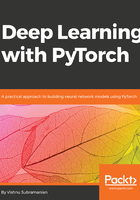
Slicing tensors
A common thing to do with a tensor is to slice a portion of it. A simple example could be choosing the first five elements of a one-dimensional tensor; let's call the tensor sales. We use a simple notation, sales[:slice_index] where slice_index represents the index where you want to slice the tensor:
sales = torch.FloatTensor([1000.0,323.2,333.4,444.5,1000.0,323.2,333.4,444.5])
sales[:5]
1000.0000
323.2000
333.4000
444.5000
1000.0000
[torch.FloatTensor of size 5]
sales[:-5]
1000.0000
323.2000
333.4000
[torch.FloatTensor of size 3]
Let's do more interesting things with our panda image, such as see what the panda image looks like when only one channel is chosen and see how to select the face of the panda.
Here, we select only one channel from the panda image:
plt.imshow(panda_tensor[:,:,0].numpy())
#0 represents the first channel of RGB
The output is as follows:

Now, lets crop the image. Say we want to build a face detector for pandas and we need just the face of a panda for that. We crop the tensor image such that it contains only the panda's face:
plt.imshow(panda_tensor[25:175,60:130,0].numpy())
The output is as follows:

Another common example would be where you need to pick a specific element of a tensor:
#torch.eye(shape) produces an diagonal matrix with 1 as it diagonal #elements.
sales = torch.eye(3,3)
sales[0,1]
Output- 0.00.0
We will revisit image data in Chapter 5, Deep Learning for Computer Vision, when we discuss using CNNs to build image classifiers.